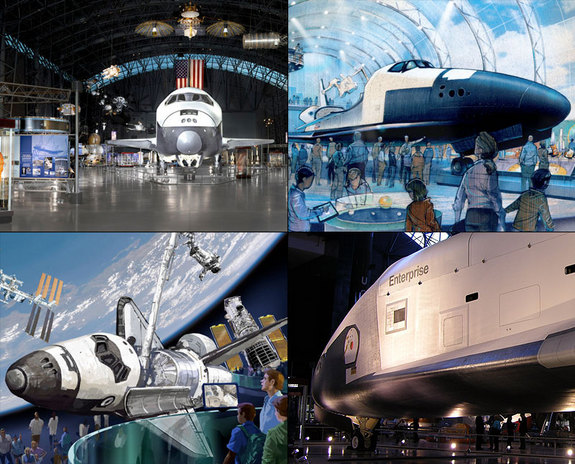NASA Gives Space Shuttles to Smithsonian and Museums in Calif., Florida and NYC

CAPE CANAVERAL, Fla. — NASA unveiled the final flight plans for its three retiring space shuttles on Tuesday, assigning two to museums in Washington, DC and California, and keeping the third at its launch and landing site in Florida. A fourth, prototype orbiter will also go to a new home in New York.
NASA Administrator Charles Bolden announced the long-awaited news during an employee event held at Kennedy commemorating the 30th anniversary of the space shuttle program. STS-1, the maiden flight for the winged reusable spaceship fleet, lifted off on April 12, 1981.
The announcement means that NASA space shuttles will eventually go on display on both coasts of the U.S., with three along the East Coast. [The Most Memorable Shuttle Missions]
Space shuttle Discovery, NASA's oldest remaining orbiter and the world's most flown spacecraft, will be displayed by the Smithsonian's National Air and Space Museum at its Steven F. Udvar-Hazy Center near Dulles International Airport.
The shuttle Endeavour, which will launch on its own final mission later this month, will be given to the California Science Center, a department of the State of California, in Los Angeles.
Shuttle Atlantis will remain in Florida to be exhibited at the spaceport's official visitor complex after launching on the 135th and last mission of NASA's shuttle program in late June.
Bolden also announced that the atmospheric test orbiter Enterprise, which has belonged to the Smithsonian since 1982 and has been on display at the Udvar-Hazy Center since 2003, will be transferred to the Intrepid Sea, Air and Space Museum, a converted aircraft carrier docked to a pier in New York City, to make way for Discovery to enter the national collection.
Sign up for the Live Science daily newsletter now
Get the world’s most fascinating discoveries delivered straight to your inbox.
"We want to thank all of the locations that expressed an interest in one of these national treasures," Bolden said. "This was a very difficult decision, but one that was made with the American public in mind. In the end, these choices provide the greatest number of people with the best opportunity to share in the history and accomplishments of NASA's remarkable space shuttle program."
Showcasing the shuttles
At present, NASA plans to have the shuttles ready to ship to their museums by early- to mid-next year.
For those going to sites outside of Florida, the orbiters will be attached to the back of NASA's modified Boeing 747 airliner and ferried to their new homes. Cranes will offload the shuttles from the carrier aircraft at the recipient cities' airports and then, depending on the location, the orbiters will be further moved to their display buildings. [How to display a retired space shuttle]
At the National Air and Space Museum's Udvar-Hazy just outside Washington, D.C., Discovery will be rolled into the James S. McDonnell Space Hangar, where it will serve as the centerpiece for an exhibit hall already filled with other historic space artifacts.
As Discovery moves in, Enterprise will be shipped up the coast to the Intrepid in New York. Too large to fit on the deck of the aircraft carrier and still have room for the other aircraft already on display, Enterprise will be housed in a planned glass-enclosed hangar that will sit alongside the Intrepid on Pier 86, where the museum's Concorde jet sits now. According to an artist's concept drawings, Enterprise will be displayed with its payload bay open, surrounded by interactive educational exhibits.
Endeavour will be sent west, joining the space exhibits at the California Science Center, where Mercury, Gemini and Apollo spacecraft are already on display. Unlike the other museums selected, the science center did not pre-release its exhibit design concepts for the orbiter.
At the Kennedy Space Center Visitor Complex in Florida, Atlantis will be suspended such that it appears to be back in orbit around the Earth. As proposed, a multi-story digital projection of the home planet will rotate behind the orbiter in a new $100 million, 64,000 square-foot indoor facility.
Kennedy's display is designed to compliment its existing Shuttle Launch Experience, which opened in 2007 to give visitors the chance to feel what it was like to ride to space aboard one of the orbiters.
"These facilities we've chosen have a noteworthy legacy of preserving space artifacts and providing outstanding access to U.S. and international visitors," Bolden said.
More suitors than shuttles
Bolden's announcement Tuesday came three years after NASA first said it would give its retired space shuttles to U.S. museums or educational institutions. Solicitations in 2008 and then again last year identified 21 organizations vying for an orbiter.
Museums needed to provide an environmentally-controlled indoor exhibit space and be able to afford the estimated $28.8 million needed to prepare the orbiter and transport it for display (Congress waived the fee for the Smithsonian).
Continue reading at collectSPACE.com to learn more about NASA’s space shuttle display selection process.
This article was provided by SPACE.com, a sister site to LiveScience. Robert Pearlman is editor of collectSPACE.com. You can follow him on Twitter at @robertpearlman and collectSPACE at @collectSPACE.










